24 - Small Intestine
Editors: Mills, Stacey E.
Title: Histology for Pathologists, 3rd Edition
Copyright 2007 Lippincott Williams & Wilkins
> Table of Contents > VIII - Hematopoietic System > 31 - Lymph Nodes
31
Lymph Nodes
Paul van der Valk
Chris J.L.M. Meijer
Introduction
The lymph nodes are an integral part of the immune system, a complex system whose job is to adequately deal with foreign substances (1). Dealing with here is taken in the broadest sense: it can mean either ignoring an antigen entirely (i.e., tolerance) or mounting a destructive reaction to the antigen, clearing it from the system. In certain areas of the body, an effective elimination is, of course, vitally important. This is certainly true for lymph nodes in areas where antigens serve no purpose and are therefore best eliminated. In contrast, in areas such as the gastrointestinal tract, reactivity against food antigens is not always advantageous, and tolerance is often the better response. As lymph nodes deal with antigens, their histology reflects the (re)activity of the immune system; the nature of the antigen determines whether a reaction will be mounted against it but also determines what effector cells will be employed. This will be reflected in the morphology of the lymph nodes, as will be discussed later.
As the entire body is continually confronted with antigens, lymph nodes are required throughout the body and are concentrated in areas draining organs with environmental contact. The skin has numerous draining lymph nodes, partly grouped in areas where lymphatics converge, such as the axillary, cervical, and inguinal regions. The gastrointestinal tract and the airways have small collections of lymphoid cells in their mucosal surfaces (the so-called mucosa-associated lymphoid tissue, or MALT), as well as draining lymph nodes in the mesenteric or the mediastinal
P.764
and hilar regions (2,3,4,5). Drainage from extra-abdominal areas is through the para-iliac and para-aortic nodes. All these systems converge on a single lymphatic channel, the thoracic duct, which returns the lymphatic fluid to the bloodstream. The only organ where no lymphatics are found is the brain, which drains its extracellular fluid via the cerebrospinal fluid or the extra-parenchymatous Virchow-Robin space.
Under antigenic pressure, lymph nodes can become apparent in areas where they are usually not found. Whether this appearance is actually an enlargement of very small lymph nodes already present or de novo formation of a lymph node is uncertain.
Embryology/Developmental Changes
Relatively little is known about the embryonic development of lymph nodes. They seem to arise from the lymphatic sacs, which in turn develop from the venous system. From the sacs, a lymphatic plexus forms; and, as early as the first trimester, small collections of lymphoblasts can be found in association with this plexus (6). In the second trimester, differentiation into cortex and medulla begins to take place, gradually forming the familiar compartmentalized structure of the lymph node parenchyma. This process is probably also under the influence of nonlymphoid cells (such as macrophages and interdigitating dendritic cells) and mesenchymally derived cells (such as follicular dendritic cells and, perhaps, fibroblastic reticulum cells). After the compartmentalization of the lymph node is completed, no other changes take place except those that follow antigenic challenge.
Gross Features
Reactive lymph nodes are mostly small structures, round or reniform in shape. When clinically detectable, they are usually enlarged due to some degree of stimulation. Normally, they do not exceed a diameter of 1 cm, although during immune reactions they can become considerably larger. A diameter of more than 3 cm, however, is unusual (though not unheard of) in benign lymph nodes and should raise the suspicion of malignancy. The cut surface of a lymph node is a pink-brown in color and homogenous. A white ( fish meat ) aspect or distinct nodularity is suspicious for maligancy (lymphoma). In lymph node dissection specimens, the lymph nodes often consist of small rims of parenchyma enclosing fatty tissue. They can be difficult for pathologists to spot grossly; but, in those cases, their resistance to the palpating finger gives them away.
Anatomy
Blood Supply
Arterioles enter the lymph node through the hilus, branch, and then rapidly form a plexus of capillaries in the parenchyma. Subtle differences exist at the level of the basement membrane between the capillaries in the follicles and those in the paracortex. Laminin-5 is found exclusively in the basement membranes of the follicular compartment (7). It is also very likely that, at the level of the endothelial cells, differences in expression of surface markers (such as chemokine receptors) also exist, though these have not yet been formally demonstrated. Such differences likely play a role in the positioning of lymphocytes in the differing nodal compartments.
Venous drainage channels accompany the arterioles. The postcapillary venules in the lymph nodes are special, as they are the main route for the entrance of lymphocytes homing to the lymph nodes. They will be discussed in more detail later.
Lymphatics
The lymph node is positioned in the lymphatic system. The afferent lymphatics enter the lymph node through the capsule, draining into the subcapsular sinus. This sinus is lined by endothelial cells, but the system of branching sinuses arising from it no longer has an endothelial lining. Further discussion of the different cell types in the sinuses follows below.
Light Microscopy: The Different Compartments, Histology, and Function
Examination of a sectioned lymph node at low power reveals more or less clearly defined areas or compartments (Figure 31.1A); most obvious are the follicles, generally rounded structures with pale centers and a dark rim. The centers often show a mottled appearance. The follicles are mainly present in the cortical area (i.e., the outer area of the lymph node just below the capsule). Occasionally follicles are found in the deeper regions. Between the follicles and extending to the deeper parenchyma is an ill-defined area, the paracortex or paracortical area, recognizable by its rather pronounced vessels, the epithelioid or high endothelial venules, the specialized postcapillary venules mentioned earlier. On occasion, this area shows a mottling not unlike that of the follicles (Figure 31.1B). In the medullary region of the lymph node, if present in the specimen, low power shows dark areas separated by lighter staining ones, often in a somewhat reticular pattern. The dark areas are the
P.765
P.766
medullary cords, where plasma cells and, with appropriate stains, mast cells are found. The lighter areas between these sheets of dark-staining small lymphocytes are the sinuses, filled with histiocytes whose ample pale cytoplasm imparts the lighter coloration to this region. The sinuses run through the entire parenchyma but are especially visible in the medullary zone and directly beneath the capsule.
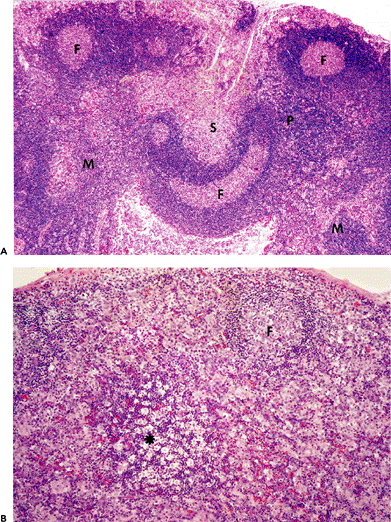 |
Figure 31.1 A. Low-power view of lymph node (periodic acid-Schiff stained, paraffin-embedded section). This smiling picture illustrates the four different compartments of the lymph node. In the upper corners and in the middle of the bottom (the eyes and mouth ) the follicles (F) are seen. The paracortical area (P) here is fairly small; usually there is more paracortex present. The less sharply defined sections where light and dark areas are juxtaposed represent the medullary cords (M, dark) and sinuses (S, light). B. Low-power view of another lymph node (H&E; paraffin-embedded section). In the upper right there is a follicle (F) recognizable. The rest of the picture shows paracortical area, with considerable influx of macrophages and interdigitating dendritic cells. In the center the typical mottling of the paracortex is seen (*). |
These different areas can be easily recognized on low-power microscopy (Figure 31.1A), but it must be stressed that their representation varies greatly in different specimens and not rarely, for instance, the medullary cords are not found.
As humans are in constant contact with antigens, a lymph node is virtually always stimulated to some degree, and the increase in one area caused by this stimulation will often be at the cost of the volume of the other compartments (Figure 31.2). Such stimulation will not only increase the size of one compartment (and decrease the size of the others), but it will also cause a shift in the cellular composition. This usually means an increase in the proliferative fraction of each compartment, the blast cells (8). This adaptability to the constantly changing antigenic challenges explains the variety in normal lymph node histology: almost all lymph nodes that come under the microscope are stimulated to some degree. Each of the four different compartments, follicle, medullary cords, paracortical area, and sinuses, is discussed separately.
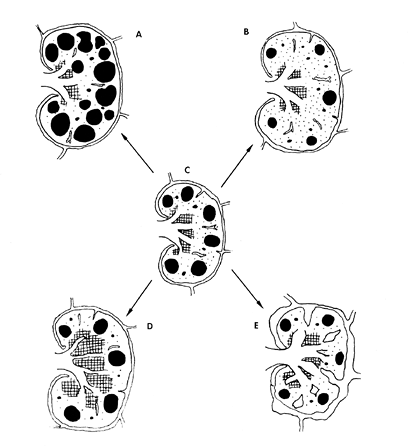 |
Figure 31.2 Schematic representation of the lymph node with enlargement of the four different compartments, respectively the follicular (A), the paracortical (B), the medullary (D) and the sinusoidal (E) compartments. C represents an unstimulated lymph node. |
The Follicle
Distinction must be made between primary and secondary follicles. Primary follicles are aggregates of small, dark-staining lymphoid cells. In these primary follicles, a germinal center can develop, turning them into secondary follicles. Thus, the mantle zone around the follicle center has the same characteristics as the original primary follicle. The outer portion of the mantle zone is somewhat less densely packed than the inner layer. This outer rim is sometimes called the marginal zone (9), largely based on a very loose resemblance to the splenic marginal zone and on the fact that marginal zone lymphomas tend to localize perifollicularly. However, if the marginal zone exists in the lymph node, it is difficult to distinguish except when it is expanded in benign or lymphomatous proliferations (10).
In the follicle center, an immunologic reaction takes place that is called, after its location, the follicle center cell reaction. It requires the cooperation of follicular dendritic cells (FDCs), lymphoid cells, and tingible body macrophages (Figure 31.3A B). The function of the reaction is the generation of B cells that have been affinity-selected against an antigen (i.e., that produce an antibody with the best possible fit to the antigen) and that can function either as a direct precursor for antibody-producing plasma cells or as (long-term) memory cells.
Follicular Dendritic Cells
Follicular dendritic cells (FDCs; previously called dendritic reticulum cells) trap antigens on their surface and present them to B cells (11,12). Because these cells can retain antigen on their surfaces, it was postulated they provide a long-lasting reaction to that antigen, which may be important for immune memory (13); however, this is controversial, and other functions have been proposed (14). Follicular dendritic cells are difficult to recognize in light microscopic sections; they were first described by electron microscopy and later by enzyme and immunohistochemistry (Figure 31.3C) (12,15,16,17). They have a large but inconspicuous nucleus with very fine, almost vesicular chromatin and a small nucleolus. Not infrequently, they are or appear binucleated, with the nuclei pressed together. The cytoplasm is largely invisible with the light microscope; but, in ultrathin sections and with immunohistochemistry, they appear to have many long and slender cytoplasmic protrusions. These are linked to the protrusions of other FDCs via (hemi)desmosomes, thus forming a round network with a fingerprint-like configuration. In this way, they are responsible for the shape of the follicle. Their origin is still a matter of debate; a derivation
P.767
P.768
from the mononuclear phagocyte system was proposed (18), as was an origin from the perivascular mesenchyme (19), possibly via a circulating mesenchymal stem cell (20).
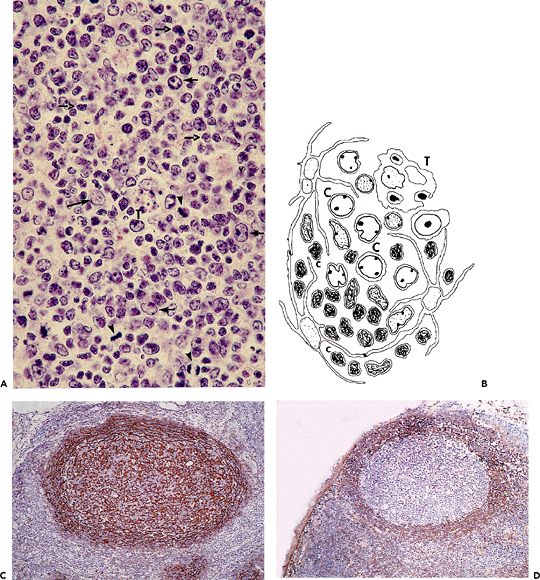 |
Figure 31.3 The follicular compartment. A. Giemsa-stained, plastic-embedded section, showing the pleomorphism of the follicle center. All typical elements are present: mitotic figures (arrowheads); a tingible body macrophage (T) with phagocytized debris, staining intensely black; blastic cells (short arrows); small follicle center cells (open arrows), and a follicular dendritic cell (FDC) (long arrow). B. Diagrammatic representation of a follicle, stressing the FDC morphology. Other elements are tingible body macrophage (T) and blastic (C) and small (c) lymphoid cells. C. Frozen section stained with a CD35 antibody against the C3b-receptor on FDCs. Note the somewhat fingerprint-like pattern of the FDC lattice. D. Frozen section stained for IgD. The mantle cells are positive; the cells in the center are not. |
Lymphoid Cells
The lymphoid cells of the primary follicle and the mantle zone have small, slightly irregular nuclei, with condensed, dark-staining chromatin. They have scanty cytoplasm and, consequently, are packed closely together. The outer rim of the mantle zone, the marginal zone equivalent of the lymph node, houses cells that are slightly bigger and less densely packed, but they have the same dark nuclei (9). All of these cells are B cells, staining with antibodies to CD20, 22, and 24. They also express IgM on their surface, and the mantle zone cells proper also express IgD simultaneously (Figure 31.3D) (17,21,22,23). In the germinal center, distinctive B cells can be found:
Blast cells with large vesicular nuclei and several small but distinct nucleoli, often located at the nuclear membrane. When they are round, they have a small rim of basophilic cytoplasm, especially well-appreciated in cytologic preparations. These are the proliferative cells of the follicle; where they predominate, mitotic figures are easily found. Also, because of their basophilic cytoplasm, areas where they are in the majority appear dark (the dark zone of the follicle).
After the blast phase of proliferation, the cells gradually become smaller and get more irregular nuclei. As they get smaller, they lose their nucleoli and the chromatin condenses. This leads to cells that are almost indistinguishable from the mantle cells; small, irregular cells with dark-staining nuclei and virtually invisible cytoplasm. These cells are less densely packed, and the areas where they predominate (the light zones) appear a little lighter than the dark zones. Naturally, cells in transition between large round to small irregular are frequent, giving rise to a particularly polymorphic cellular picture, with a mixture of cells that are large, medium-sized, or small, round or irregular and with vesicular or condensed chromatin.
A smaller portion of the cells are medium-sized to large, with a finely dispersed chromatin and inconspicuous nucleoli and scanty but intensely basophilic cytoplasm (lymphoblasts).
Other lymphoid cells include occasional plasma cells and immunoblasts (i.e., very large blastic cells with big vesicular nuclei and single centrally placed nucleoli) and small, dark-staining lymphocytes (a little smaller than the small follicle center cells themselves), probably representing T lymphocytes. The number of these various cells varies considerably. On occasion, plasma cells can be quite numerous; also, T lymphocytes can outnumber the B lymphocytes in the follicle.
As follicle center cells are B cells, too, they react with the same markers as mentioned for the mantle and marginal zone cells (with the exception of IgD). In addition, they are mostly positive for the markers CD10 and Bcl-6, considered markers of follicle center cells (23).
Tingible-Body Macrophages
Tingible-body macrophages (TBMs) are large cells with abundant, pale cytoplasm. The cytoplasm contains phagocytized debris and apoptotic bodies from surrounding lymphocytes that have died in the selection process that takes place in the follicle (see Function section, below). Tingible-body macrophages have large nuclei, with finely dispersed chromatin. Because their nuclear size is fairly constant, they can be used as an internal yardstick to compare to the nuclear size of the surrounding lymphocytes, especially in lymphomas (nuclei as big or bigger than a TBM nucleus means a large-cell lymphoma). The cytoplasm of TBMs is often very clear, and therefore their presence causes clear/white spots in the tissue, a mottling colorfully described as the starry sky pattern. It should be noted that this highly characteristic feature, often used to distinguish between benign and malignant, is in fact a fixation artifact. In some fixatives, such as sublimate-formaldehyde or B5, this starry sky pattern is not seen!
Variations of the Follicular Pattern
From the above information, a characteristic pattern for the morphology of the follicle emerges: a more or less round or oval area, with a dark outer edge (the mantle zone) and a lighter center, that shows mottling and, upon closer inspection, a very polymorphic cytologic picture and many mitotic figures. Sometimes zonation is seen, with the dark zone directed inwards, the light zone directed more to the capsule of the node. As it is very dependent on how the follicle is cut in the section, this zonation is often not seen (15,24).
Variations occur in the shape of the follicles and in their composition. An important cause for variation is time: the pattern described above takes time to evolve. In the beginning, the follicle consists largely of blasts, with smaller follicle center cells appearing as the follicle center cell reaction runs its course (24).
In reactive conditions, follicles can become very large and coalesce; HIV lymphadenopathy is a good example of this phenomenon (25,26,27) (Figure 31.4). Their composition can also vary somewhat. Changes that occur with malignancy are discussed later. With involution, the follicle can become hyalinized and atrophic, or it can be overrun by T lymphocytes, a phenomenon known as progressive transformation of the germinal center (15,28).
P.769
This can make the follicle difficult to recognize. It is only by their remnant round shape (and by special stains for FDCs) that they may be recognized as follicles. Fortunately, this somewhat alarming-appearing feature usually involves only a few follicles at the same time, so the presence of nearby normal follicles is reassuring.
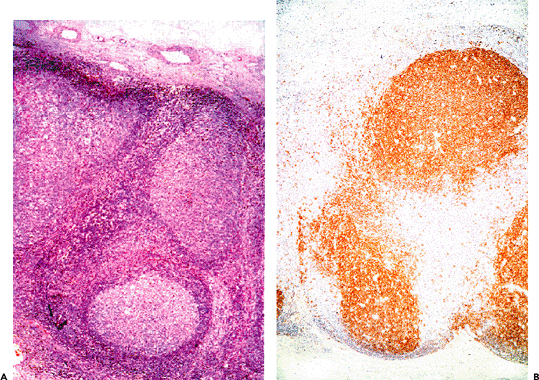 |
Figure 31.4 HIV-induced follicular hyperplasia. A. Very large and irregularly shaped follicles dominate the picture (H&E; paraffin-embedded section). B. Two follicles are seen, with ragged borders showing beginning follicular disintegration (CD20 stain). |
The Medullary Cords
The medullary cords are found in the hilar region of the lymph node, between the sinuses. The cellular composition of this compartment is described next (Figure 31.5).
Lymphoid Cells
Small lymphocytes make up the majority of cells in the medullary cords. They have small, more or less round nuclei and a scant-to-moderate amount of cytoplasm. In some cells, the chromatin is clumped and peripherally distributed in the nucleus, similar to the plasma cell nucleus, though the typical clock face chromatin of a mature plasma cell is not seen. Cells with this kind of chromatin tend to have more cytoplasm and sometimes even a perinuclear hof, clearly indicative of plasmacytoid differentiation. These are called lymphoplasmacytoid or lymphoplasmacytic cells. Immunologically, the cells can be identified with CD20 and, even better with CD79a, general B cell markers. Staining for immunoglobulins can sometimes show cytoplasmic IgM and light chains. Many of the cells with less cytoplasm and irregular nuclei are T lymphocytes (CD2-, 3-, 5-, and 7-positive), necessary to modulate or drive the process of antibody formation that takes place in the medullary cords. The blast cells of this process, the immunoblasts, are striking, though infrequent. They have large vesicular nuclei with a large, centrally located nucleolus and abundant basophilic
P.770
cytoplasm. Plasma cells are also present but in varying number. They are distinctive cells, with their small round nuclei having a clock face chromatin pattern due to small clumps of dark chromatin at the nuclear membrane, like the numbers on a dial. The nucleus is eccentrically located in the cytoplasm, with a perinuclear hof or small zone of cytoplasmic clearing. The outer rim of the cytoplasm is deeply basophilic. Under some conditions, plasma cells accumulate immunoglobulins in their cytoplasm, forming so-called Russell bodies, globular structures that stain positive with PAS and that can indent the nucleus if they reach sufficient size. Plasma cells are CD20-negative but retain their CD79a expression and are, of course, positive for cytoplasmic immunoglobulins. Plasma cells will also (paradoxically) label for epithelial membrane antigen (EMA).
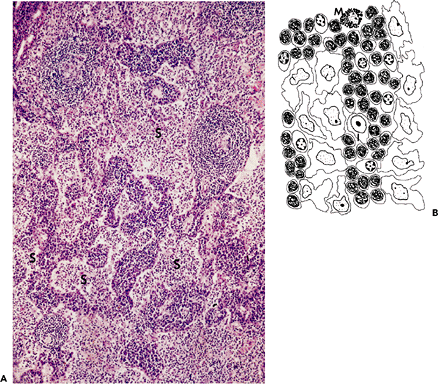 |
Figure 31.5 Medullary cords. A. The sheets and ribbons of dark-staining cells are the medullary cords, containing small lymphocytes and plasma cells; they are separated by the lighter staining areas, the sinuses (S) (H&E; paraffin-embedded section). B. Schematic representation, also depicting an immunoblast (I) and a mast cell (M). |
Macrophages
Macrophages are fairly scarce in the medullary cords. They have medium-sized to large irregular nuclei and abundant cytoplasm. They are not as avidly phagocytic as the TBMs from the follicle center, perhaps because they are differentiated more toward antigen-handling and presentation then for phagocytosis.
Other Cell Types
T lymphocytes were already mentioned. The mast cell is the other cell type that can be found especially in the medullary cords, where they can be easily demonstrated with a metachromatic dye such as a Giemsa stain. Their characteristic purple granulation permits easy recognition. The granules generally obscure the nucleus.
The Paracortex
The paracortex, or paracortical area, was the last compartment to be described and named (29), probably because its boundaries are indistinct and the area best appreciated in less commonly used fixatives, such as Zenker's or sublimate-formaldehyde. Nevertheless, it has some typical structural elements that allow easy recognition the epithelioid venules and the interdigitating dendritic cell (IDC) (Figure 31.6).
P.771
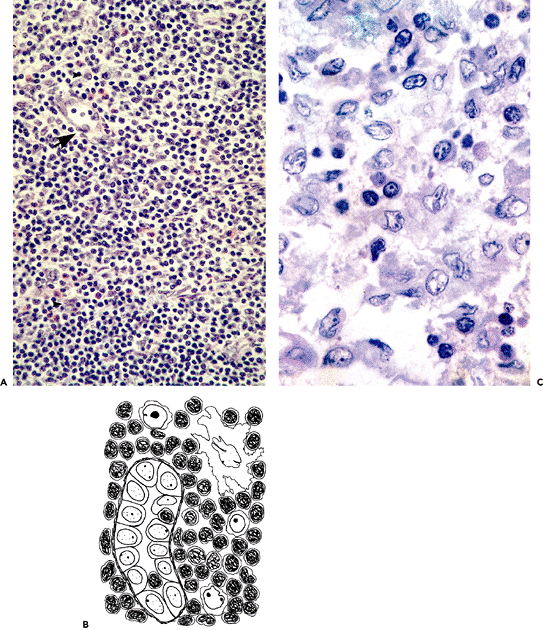 |
Figure 31.6 The paracortex. A. An epithelioid venule is seen (arrow); small lymphocytes dominate the picture, with an occasional blast present; interdigitating dendritic cells (IDCs), with their markedly irregular, grooved, and pale nuclei are scattered throughout the area (arrowheads) (H&E; paraffin-embedded section). B. Schematic representation. Note the typical IDC. C. This section demonstrates an increase in IDCs, characteristically displaying their irregular pale nuclei and abundant cytoplasm (lymph node with dermatopathic lymphadenopathy)(Giemsa; plastic-embedded section). |
P.772
Epithelioid (Postcapillary or High Endothelial) Venules
These highly distinct vessels are found only in the paracortex; they are lined with plump cuboidal or even cylindrical endothelial cells with fairly large oval nuclei, with vesicular chromatin and indistinct nucleoli. Sometimes the lumina of these vessels appear to be obliterated by the endothelium. These vessels have long since been recognized as the port of entrance for bloodborne lymphocytes to the lymph node parenchyma (30,31). Therefore, they play a crucial role in recirculation, distribution, and homing of lymphocytes in different lymphoid organs, a process mediated by specific homing receptors on the lymphocyte surface, that react with organ-specific ligands (or vascular addressins) on the endothelial cell surface (32,33,34,35) (Figure 31.7). In this process chemokines also play an important role (36,37).
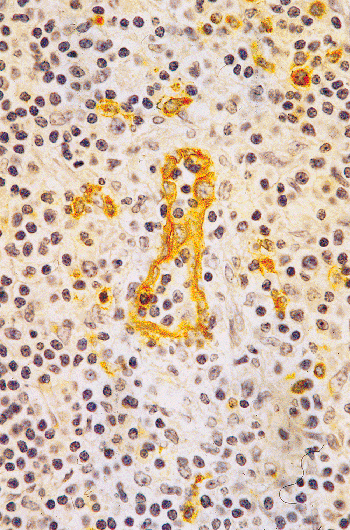 |
Figure 31.7 Paracortical area with a highlighted epithelioid venule. Lymphocytes are seen adhering to the endothelium and passing through the vessel wall (HECA 452 stain). |
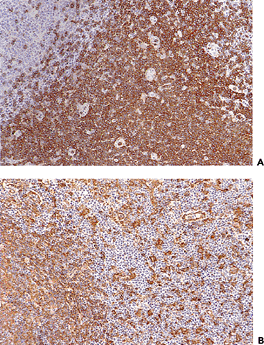 |
Figure 31.8 Immunohistochemistry of paracortex. A. The vast majority of the cells in the paracortex stain positive for CD3 (frozen section). In the upper left corner, a segment of a follicle (B-cell area) is seen. B. Here, the IDCs stain positive for HLA-DR (frozen section); they are larger and show more cytoplasm than the group of follicular (B) cells on the left. |
Interdigitating Dendritic Cells
Interdigitating dendritic cells (IDCs) are large cells with large and bizarre nuclei having deep clefts and folds. The chromatin pattern is delicate, almost transparent, and nucleoli are inconspicuous. The cytoplasm is abundant, pale, and with ill-defined borders (Figure 31.6C). Electron microscopy shows protrusions, broad and veil-like, in contrast to the thin processes of the FDC. Contact points are lacking. Furthermore, IDCs have a typical organelle of undetermined function: the tubulovesicular system (15). When present in large numbers IDCs cause a mottling of the paracortex.
The IDC is a bone marrow-derived cell, intimately related to the Langerhans cell of the skin, which it closely resembles, both morphologically and functionally (38,39,40,41). Both are antigen-presenting cells to T lymphocytes, important to initiate and/or maintain immune responses. Immunologically, these cells are best demonstrated in stains for S-100 protein or by HLA-DR, among the class II negative T lymphocytes (Figure 31.8).
P.773
Lymphoid Cells
The cytology of the paracortex is somewhat variable; but, in the majority of cases, small T lymphocytes predominate. They have small, irregular nuclei with coarse chromatin and little cytoplasm. They are demonstrated with stains for CD2, 3 (Figure 31.8), 5, and 7 and are either CD4- or CD8-positive, with CD4-positive cells outnumbering the CD8-positive ones. Blast cells are present in varying numbers; they are large cells with vesicular nuclei of a varying shape.
Other Cell Types
The fibroblastic reticulum cell (FRC) is often found at the edge of the paracortex (15). It is a somewhat functionally enigmatic cell that forms reticulin fibers involved in the transport of cytokines and/or antigens through the parenchyma. This so-called FRC conduit system is an effective means of spreading important activating molecules throughout the entire lymph node (42).
The Sinuses
The sinuses are the structures carrying the lymphatic fluid from the afferent lymphatics through the lymph node to the efferent lymph vessels. The afferent lymph vessels drain into the subcapsular sinus, a structure at least partly lined by endothelium. As the sinuses traverse through the lymph node, they lose their endothelial lining and acquire a lining of macrophages (43). The macrophages in the sinuses are similar to macrophages elsewhere. They are large cells with large, irregular, and vesicular nuclei, a low nuclear-to-cytoplasmic ratio, and signs of phagocytotic activity.
Apart from the macrophages, which look the same here as elsewhere in the lymph node, small lymphocytes are also found in the sinuses (Figures 31.5A, 31.9A). In addition, occasional neutrophils or eosinophils can be found here as well.
Mention must be made of two other cell types. The first is the so-called sinus-lining cell, an ill-defined cell type that is primarily recognized with immunohistochemical stains for keratins. It is found in the area of the subcapsular sinus and has a coarsely dendritic morphology (44). Its nature is unclear; but, in evaluating lymph node sections for metastatic tumor, it is important to be aware of these cells and not confuse them with tumor cells. The second is the so-called immature sinus histiocyte, a misnomer as these are B lymphocytes (Figure 31.9B and C). These cells are primarily seen in certain reactive conditions in which they can partially fill the sinuses. They have small, more lymphoid appearing nuclei but have ample cytoplasm. Also called monocytoid B cells (another unfortunate name!), they are indeed B-lymphocytes, probably marginal zone cells (45,46).
Function
Each of the above-described compartments has a specific function, housing its own immunological reaction. Together these reactions make up the individual's immunologic integrity.
In the follicle, the follicle center cell reaction takes place. In this reaction the na ve B lymphocytes are exposed to antigen (on the FDC surface), and they adapt their antigen receptor (the immunoglobulin) to make a perfect fit to the presented antigen by a process called somatic hypermutation. This involves rearranging their immunoglobulin receptor genes through a partially trial-and-error process. Thus, some of the changes are actually for the worse and decrease the fit. Such cells are ruthlessly eliminated through apoptosis (hence the many apoptotic cells in this compartment). Eventually though, a perfect fit is achieved, and the cell is rescued from elimination by expressing the anti-apoptotic Bcl-2 molecule. Normal follicles, where selection takes place, are therefore negative for Bcl-2. Typically, several clones are developing in a single follicle, making it an oligoclonal proliferation (47).
Through this complicated molecular biologic process of antibody selection, the follicle center cell reaction results in B cells that express high avidity antibodies on their surface. These cells can recirculate through the body as memory cells, spreading immune competence through the entire body and waiting for another encounter with the antigen; others go to the medullary cords or to the bone marrow to enter the plasma cell reaction and develop into plasma cells that produce antibodies for secretion.
In the medullary cords, the plasma cell reaction takes place. As mentioned above, it leads to the formation of plasma cells and the secretion of antibodies. The antibody production in the lymph node does not substantially contribute to the level of circulating antibodies, but it may be locally important, for instance for fixing antibodies on FDCs.
In the paracortex, we find the specific cellular response that generates antigen-specific effector T lymphocytes of the various subsets: helper cells, suppressor cells, regulatory cells, memory cells, and maybe more (32). The cellular processes here are still poorly understood. It is likely that T-cell memory, cytokine production, and a number of other reactions take place in the paracortex, but little is known about this. Its role in the delayed-type contact hypersensitivity is well-recognized (29).
The sinuses, with their abundant macrophages, are a filtering system, clearing foreign substances from the lymph. Given their ability to handle antigens, a function in antigen-presenting might be plausible, but little is known about this.
P.774
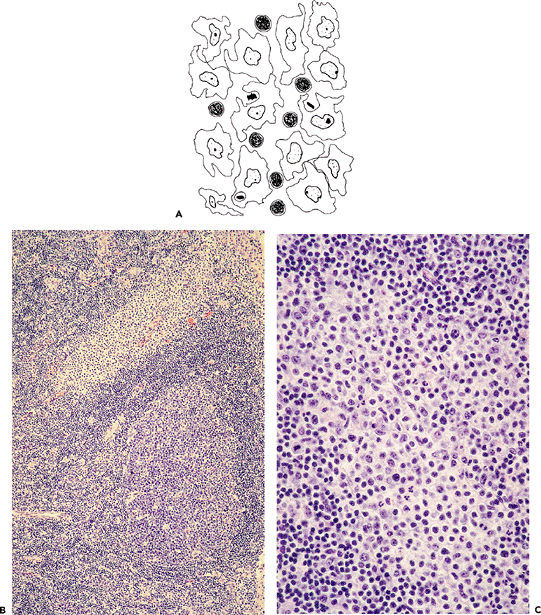 |
Figure 31.9 The sinuses. A. Schematic representation with predominance of macrophages and some lymphocytes. B. Low-power view of immature sinus histiocytosis, recognizable as the pale area to the upper left of the central follicle. C. Detail of B, showing the cells to be somewhat larger than the dark, small lymphocytes and having fairly abundant cytoplasm. |
P.775
Changes in Compartments: Benign Versus Malignant
The differential diagnosis of benign and malignant lesions is important in the discussion of normal lymph node histology for two reasons: (a) it is naturally of the utmost importance for the surgical pathologist to decide between benign and malignant, and (b) it is often difficult to distinguish between these two. The first goes without saying; the second can be clarified somewhat.
Though a link between normal tissue and the tumors arising from them has been self-evident for epithelial neoplasms, the same insight for lymphomas and lymph node structure was slow to arrive. However, this has been firmly established through careful morphologic and immunologic studies. We now regard the (non-Hodgkin's) lymphomas as malignant counterparts of the normal immunologic reactions to antigens that take place in the different compartments of the lymphoid tissues (15,48,49,50). Lymphoma cells have similar morphologic, immunologic, and functional characteristics when compared with normal cells. This explains why a malignant process can resemble a reactive condition so closely. Table 31.1 relates some of the benign variations in normal histology to their malignant counterparts. As this chapter deals with normal histology and many excellent texts have been written on lymphomas, we will discuss this matter only briefly.
Follicular Changes
The most important issue here is the distinction between follicular hyperplasia and follicular lymphoma. The term follicular hyperplasia covers a large number of conditions, most of which are difficult to differentiate from each other on morphologic grounds. Thus, it occurs in: (a) lymph nodes in the vicinity of a (bacterial) inflammation [e.g., tonsillitis but also in syphilis (51)]; (b) in autoimmune diseases, such as rheumatoid arthritis and systemic lupus erythematosus (52,53); (c) viral infections, such as HIV (25,26); and (d) in a number of idiopathic conditions, such as Castleman's disease, multicentric angiofollicular hyperplasia, reactive lymph node hyperplasia with giant follicles (54,55,56,57). (It is by no means clear that these are all separate entities.) Sometimes special stains can help in elucidating causation (spirochetal stains, p24 for HIV). In essence, the follicles are all more or less the same, so they are taken together here.
Table 31.1 Benign Compartmental Enlargement and Their Malignant Counterparts | |||||||||||||||||||||
|---|---|---|---|---|---|---|---|---|---|---|---|---|---|---|---|---|---|---|---|---|---|
|
The most important morphologic criteria arguing for a benign lesion, mentioned in the literature (15,53,58,59,60,61,62) are:
Cellular pleiomorphism of the follicle center
Presence of TBMs
High number of mitotic figures
Well-defined mantle zone
Differences in size and shape of the follicles
Low number of follicles per surface area and predominant cortical localization
Well-developed and intact FDC networks in the follicle center
Zonation of the follicles, with clear dark and light zone
Despite this impressive list of criteria it may not be possible in all cases, even by an experienced pathologist, to distinguish reliably between benign and malignant on morphologic features alone. Therefore, there are some additional roles from immunohistochemistry and molecular biology (63). Features of malignancy by these techniques include: (a) demonstration of light chain restriction by immunohistochemistry (expression of either - or - light chain by follicular lesions is considered proof of malignancy); (b) expression of Bcl-2 by follicle center cells; (c) demonstration of clonality by detection of rearrangement of immunoglobulin genes, either by Southern blotting or by polymerase chain reaction (PCR) analysis; and (d) demonstration of a t(14;18) translocation (perhaps not 100% proof but a very strong argument).
Even with these additional techniques, it is not possible to diagnose all cases with certainty. It is good to realize that the majority of the lymph nodes encountered by pathologists are quickly scanned and interpreted, and rarely cause diagnostic problems. However, a high index of suspicion is
P.776
probably a good general attitude, simply because of the occasional treacherous similarities between benign and malignant follicular processes.
Changes in the Medullary Cords
Two distinctions can be important when examining changes in medullary cords. The first is reactive plasmacytosis (Figure 31.10) versus plasmacytoma. Preserved lymph node architecture and the presence of plasma cell precursors strongly favor the diagnosis of a reactive condition (15). In rare doubtful cases, immunohistochemistry can clinch the diagnosis by demonstrating light chain restriction. Second, expansion of the medullary cords, a rare event in itself, can be mimicked by a lymphoplasmacytic lymphoma. In rare instances, this lymphoma does not efface the architecture but expands the medullary cords. If the expansion is sufficient to arouse suspicion, marker studies can settle this easily, again by showing light chain restriction. It is good to realize that demonstrating clonality in paraffin sections may be difficult due to diffusion artifacts. The intercellular fluid is rich in immunoglobulins, and these can diffuse into the cells of a specimen if fixation is delayed. Subsequent fixation will trap the polyclonal immunoglobulins inside the cells, potentially obscuring monoclonality. In practice, when a lesion is clearly monoclonal, this will be demonstrable; however, caution must be taken in interpreting immunoglobulin stains.
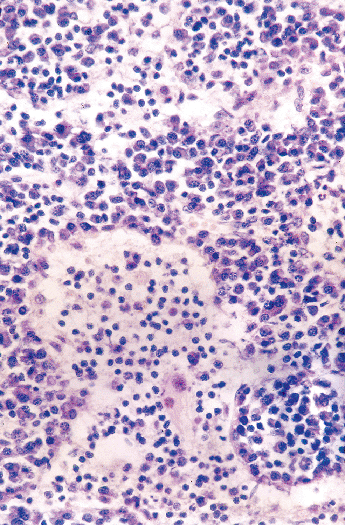 |
Figure 31.10 Reactive plasmacytosis. The medullary cords here consist almost entirely of plasma cells; sinuses are patent, a sign of preserved lymph node structure (H&E; paraffin-embedded section). |
Changes in the Paracortex
Paracortical hyperplasia can take three forms, each with their own differential diagnostic considerations.
Expansion of the paracortex by predominantly small lymphocytes, usually with an increase in epithelioid venules. Distinctive features, suggestive of malignancy are cellular monotony and destruction of lymph node architecture by the proliferation. Immunohistochemical features that may be supportive are: (a) demonstration of an aberrant phenotype (e.g., strong predominance of CD4 or CD8), loss of markers that are normally present (such as CD7 or CD5), or expression of markers normally not expressed by lymph node T cells (such as CD1); and (b) demonstration of clonality by molecular biology [i.e., Southern blotting or PCR analysis of the T cell receptor chains (64,65)].
Expansion with an increase of blasts. This can be seen in viral infections or following vaccinations, as well as in some drug reactions (the antiepileptic drugs featured prominently here) (53,60,66,67). The changes can be histologically very alarming for malignancy. In some conditions, even necrosis can occur, such as in Kikuchi's histiocytic necrotizing lymphadenitis (68). On occasion, the changes can exhibit a nodular pattern (69). In such cases, a preserved architecture should raise the possibility of a benign condition, regardless of the histologic picture. Simple analysis with immunohistochemistry will reveal blasts of B-cell origin next to blasts of T-cell origin; also mitotic cells labelled by both B-cell and T-cell markers argue strongly for a benign proliferation and against a peripheral T-cell lymphoma. A differential diagnosis with Hodgkin's disease is also sometimes a consideration; Reed-Sternberg cells can be found in reactive conditions. Therefore, this differential can be very problematic. It should be kept in mind, however, that cases of Hodgkin's disease with intact lymph node architecture are rare. In short, this pattern can be extremely difficult to interpret; a combination of clinical history, morphology, immunophenotyping, and molecular biology (demonstration of clonality) must bring about a final diagnosis.
Dermatopathic lymphadenopathy. In this pattern, seen in lymph nodes draining skin areas with itching skin disorders, the paracortex is expanded by a marked increase in IDCs and Langerhans cells (70,71). It is mentioned here, because the skin lymphomas, mycosis fungoides, and the S zary syndrome, when they involve the lymph nodes, will do so in the background of a dermatopathic lymphadenopathy. This problem will
P.777
thus arise only in the setting of a patient known to suffer from one of these skin lymphomas. That does not make the problem easier in itself. The only way to arrive at the diagnosis is to make a careful search for the diagnostic large cerebriform mononuclear cells, which can be difficult to find (72,73). Their demonstration is clinically very relevant (74). Immunohistochemistry and molecular biology unfortunately are not helpful here (75).
Sinusoidal Changes
Sinusoidal changes are very common in lymph node specimens. Lymph nodes draining tumors or inflammatory areas often show sinus histiocytosis. Typical conditions showing a sinusoidal pattern include sinus histiocytosis with massive lymphadenopathy (76,77) and Langerhans cell histiocytosis (60,78). The former condition is a peculiar clinicopathological entity in which the histiocytes seem to engulf large numbers of lymphocytes in their cytoplasm without destroying them, a phenomenon dubbed emperipolesis. This is a highly characteristic finding. The latter can also cause a (mostly but not always benign) sinus histiocytosis. The typical features of Langerhans cells, with their deeply grooved nuclei and the admixture with eosinophils, are important clues. Immunohistochemistry with CD1 (and S-100) will prove the true nature of the cells. Malignant conditions in the sinuses are almost always easily recognized on histology as frankly malignant. Metastatic carcinoma or melanoma, large-cell anaplastic lymphoma (79), and malignant histiocytosis (80) all can be difficult to distinguish from one another, but doubts about their malignancy are rare.
As mentioned above, the sinuses can be filled with immature sinus histiocytes or monocytoid B cells. A malignant equivalent is nodal marginal zone B-cell lymphoma (81). A predominant sinusoidal localization of such a lymphoma is rare but can occur. Demonstration of clonality is helpful and necessary in such cases.
Finally a particular sinusoidal pattern involving vessels can be seen on occasion, often as a reaction of the lymph node to ischemia or irradiation. This pattern is called vascular transformation of the sinuses and can show some histological variation, from a delicate vascular pattern to a more spindle-cell proliferation resembling Kaposi's sarcoma (82).
Combined Patterns
Follicular, medullary, paracortical, and sinusoidal patterns often occur simultaneously, and any combination is possible. As combined patterns are extremely rare in lymphomas, any combination argues for a benign condition. For example, Toxoplasma and Epstein-Barr virus infections often cause combined patterns. If suspicions of a malignancy arise, the same criteria as mentioned for the single patterns apply.
In addition a number of other patterns may occur, such as granulomatous patterns. As this chapter cannot aspire to completeness and this is not a treatise on benign conditions of the lymph node, they will not be discussed further.
Artifacts
A number of extrinsic and intrinsic factors can influence lymph node histology. Though they are not patterns, they can cause considerable difficulties in evaluating histology and are therefore mentioned here.
Technical Artifacts
Lymph node tissue is vulnerable and easily damaged in processing. Undue pressure on a specimen during dissection can cause considerable crushing artifact, to the point of obliterating morphology completely. Specimens with extensive crushing artifacts should best not be evaluated. Differences are already subtle, and no chance should be taken with poor material.
Another disturbing artifact is fixation related. It occurs especially in large specimens or if processing is too quick. If the fixation time in formalin is too short, only the outer edge of the specimen is fixed. The central part will not be reached by the formalin and will be fixed in the alcohol of the dehydrating series. This causes a marked difference in the histologic appearance of outer and inner segments. The inner segment shows loss of cohesion, and cells appear more shrunken and hyperchromatic (Figure 31.11). Great care should be taken in evaluating such specimens.
Intrinsic Artifacts
Though the lymph node architecture described above is found in all nodes throughout the body, in some areas typical changes can be found, mostly the result of repeated inflammation or reactions. These changes are most often seen in inguinal nodes and take the form of deposits of fibrotic material that can distort the normal architecture. This should be kept in mind when evaluating such specimens. Similarly, in retroperitoneal lymph nodes, hyalinization can be found.
Handling of Lymph Node Specimens
In an area where morphologic differences are (very) subtle, additional techniques can be decisive in making a diagnosis. In the past, this meant having snap-frozen material
P.778
available to do marker studies and/or Southern blotting. However, at the moment, all commonly used markers in characterizing lymphoid tissues and their tumors are applicable on formalin-fixed, paraffin-embedded material. In addition, though Southern blotting is still the most sensitive and reliable technique, PCR analysis with multiple primers is a good alternative for molecular biologic evaluation of gene rearrangements and translocation. Nevertheless, it is still good policy to ask clinicians to send in lymph node specimens fresh and to snap-freeze a part of the specimen. It is no longer necessary to use a special fixative for immunohistochemistry (Bouin's fixative, sublimate-formaldehyde, B5, Sensofix, zinc-containing fixatives, among others); most of these are toxic and damage DNA to such a degree that molecular biologic analysis becomes impossible. It can be helpful to make touch imprints, by carefully pressing the cut surface of a specimen against a slide. The cytological picture can be helpful, especially in cases where the histology is not so good.
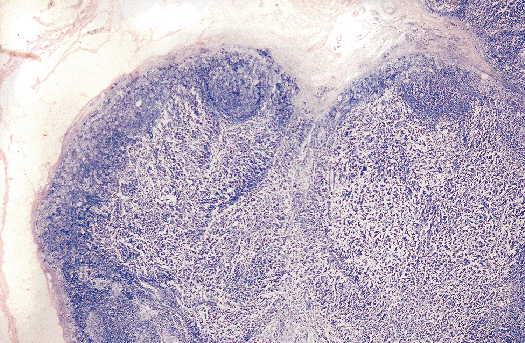 |
Figure 31.11 Fixation artifact. Edge of the specimen is properly fixed; the center, fixed in alcohol during the dehydration procedure, shows loss of tissue structure. |
Electron microscopy is not particularly helpful in diagnosing lymphoid lesions, whether benign or malignant. For very rare lesions, tumors of dendritic cells for instance, this may be of assistance, and it is a small effort to slice off a very small and thin fragment for fixation in glutaraldehyde. However, and this is a general principle, if a specimen is small, any manipulation is a risk of damaging the cells in the lesion severely and should be kept to a minimum or even avoided altogether.
If circumstances so dictate, consider sending a piece of tissue to the microbiology department for culture.
For research purposes and if the size of the specimen allows it a cell suspension can be made. Routine use of cell suspensions to perform marker analysis is not to be encouraged. One loses the morphologic control of the lesion and its cells, which is extremely important.
Special Techniques and Procedures
Immunohistochemistry can hardly be described as a very special technique, given its omnipresence in pathologic diagnostics. It is, however, not always used properly. Therefore, we will stress the basic rules for this important additional technique.
Always use positive and negative controls. Given the problems with endogenous peroxidase, alkaline phosphatase, or biotin activity/presence and the very real possibility of technical mistakes, they are absolutely essential.
Use panels of antibodies. Because no single antibody is absolutely specific for one molecule and cross-reactions can be very confusing, it is sound policy to use a well-constructed panel in which individual staining results will confirm each other. Panels for classification of lymphoid lesions have been reported (83,84); they are primarily in use for classification of lymphoma but are also useful for benign lymphoid lesions and distinguishing between benign and malignant.
Use the morphology. Immunohistochemistry is an additional technique; one should always be extremely cautious if morphology and immunohistochemistry are at odds. Also, morphology can direct the interpretation of the immunohistochemistry, for instance by looking at the immunophenotype of those cells that are considered the tumor cells. In lymphoid lesions, there are always a lot of admixed cells that are also of lymphoid origin. The best example is that of a paracortical expansion where the blasts prove to be of B-cell origin with the immunohistochemistry, a strong argument for a benign process.
Use your common sense. This goes without saying. It is curious, however, how often this essential piece of advice is ignored!
P.779
By and large, similar advice goes for the use of molecular biology in the evaluation of lymphoid lesions. Controls, common sense, and the use of several primer pairs or techniques to confirm test results are equally as important here as they are for immunohistochemistry. The demonstration of clonality must be considered a (strong) argument for malignancy; however, not all clonal lesions are malignant and certainly will not behave in a malignant fashion, the obvious example being monoclonal gammopathy of undetermined significance (85). Again, the data must be interpreted in their entire context.
Even lineage determination (e.g., by demonstration of immunoglobulins or T-cell receptor rearrangements) is not absolute. The terms lineage infidelity and lineage promiscuity already suggest that there are exceptions to the rule that only B cells rearrange immunoglobulin genes and only T cells rearrange T-cell receptor genes (86,87,88,89,90). Obviously, additional techniques are invaluable in the analysis of lymphoid lesions, but only if they are properly used!
References
1. Hall JG. The functional anatomy of lymph nodes. In: Stansfeld AG, ed. Lymph Node Biopsy Interpretation. Edingburgh: Churchill Livingstone; 1985:1 25.
2. Parrott DMV. The gut as a lymphoid organ. Clin Gastroenterol 1976;5:211 228.
3. McDermott MR, Bienenstock J. Evidence for a common mucosal immunologic system. I. Migration of B immunoblasts into intestinal, respiratory, and genital tissues. J Immunol 1979;122:1892 1898.
4. Sminia T, Plesch BE. An immunohistochemical study of cells with surface and cytoplasmic immunoglobulins in situ in Peyer's patches and lamina propria of rat small intestine. Virchows Arch B Cell Pathol Incl Mol Pathol 1982;40:181 189.
5. Azzali G. Structure, lymphatic vascularization and lymphocyte migration in mucosa-associated lymphoid tissue. Immunol Rev 2003;195:178 189.
6. O'Rahilly R, M ller F. Human Embryology and Teratology. New York: Wiley-Liss; 1992.
7. Jaspars LH, van der Linden HC, Scheffer GL, Scheper RJ, Meijer CJLM. Monoclonal antibody 4C7 recognizes an endothelial basement membrame component that is selectively expressed in capillaries of lymphoid follicles. J Pathol 1993;170:121 128.
8. Taylor CR. Classification of lymphomas: new thinking on old thoughts. Arch Pathol Lab Med 1978;102:549 554.
9. van den Oord JJ, de Wolf-Peters C, Desmet VJ. The marginal zone in the human reactive lymph node. Am J Clin Pathol 1986;86:475 479.
10. Nathwani BN, Hernandez AM, Drachenberg MR. Diagnostic significance of morphologic patterns of lymphoid proliferations in lymph nodes. In: Knowles DM, ed. Neoplastic Hematopathology. 2nd ed. Philadelphia: Lippincott Williams & Wilkins; 2001:507 536.
11. Nossal GJ, Abbot A, Mitchell J, Lummus Z. Antigens in immunity. XV. Ultrastructural features of antigen capture in primary and secondary lymphoid follicles. J Exp Med 1968;127:277 290.
12. Park CS, Choi YS. How do follicular dendritic cells interact intimately with B cells in the germinal centre? Immunology 2005;114:2 10.
13. Donaldson SL, Kosco MH, Szakal AK, Tew JG. Localization of antibody-forming cells in draining lymphoid organs during long-term maintenance of the antibody response. J Leukoc Biol 1986; 40:147 157.
14. Haberman AM, Shlomchik MJ. Reassessing the function of immune-complex retention by follicular dendritic cells. Nat Rev Immunol 2003;3:757 764.
15. Parl I. The cytologic, hystologic, and functional bases for a modern classification of lymphomas. In: Lubarsch O, Henke F. Handbuch der speziellen pathologischen Anatomie und Histologie I/3/B. Berlin: Springer-Verlag; 1978:1 72.
16. Naiem M, Gerdes J, Abdulaziz Z, Stein H, Mason DY. Production of a monoclonal antibody reactive with human dendritic reticulum cells and its use in the immunohistological analysis of lymphoid tissue. J Clin Pathol 1983;36:167 175.
17. van der Valk P, van der Loo EM, Jansen J, Daha MR, Meijer CJLM. Analysis of lymphoid and dendritic cells in human lymph node, tonsil and spleen. A study using monoclonal and heterologous antibodies. Virchows Arch B Cell Pathol Incl Mol Pathol 1984;45:169 185.
18. Gerdes J, Stein H, Mason DY, Ziegler A. Human dendritic reticulum cells of lymphoid follicles: their antigenic profile and their identification as multinucleated giant cells. Virchows Arch B Cell Pathol Incl Mol Pathol 1983;42:161 172.
19. Beranek JT, Masseyeff R. Hyperplastic capillaries and their possible involvement in the pathogenesis of fibrosis. Histopathology 1986;10:543 551.
20. van Nierop K, de Groot C. Human follicular dendritic cells: function, origin and development. Semin Immunol 2002;14:251 257.
21. Stein H, Bonk A, Tolksdorf G, Lennert K, Rodt H, Gerdes J. Immunohistologic analysis of the organization of normal lymphoid tissue and non-Hodgkin's lymphomas. J Histochem Cytochem 1980;28:746 760.
22. Hsu SM, Jaffe ES. Phenotypic expression of B-lymphocytes. I. Identification with monoclonal antibodies in normal lymphoid tissue. Am J Pathol 1984;114:387 395.
23. Knowles DM. Immunophenotypic markers useful in the diagnosis and classification of hematopoietic neoplasms. In: Knowles DM, ed. Neoplastic Hematopathology. 2nd ed. Philadelphia: Lippincott Williams & Wilkins; 2001:93 226.
24. van den Oord JJ. The immune response in the human lymph node. A morphological, enzyme, and immunohistochemical study (Thesis). Leuven, Belgium: University of Leuven; 1985.
25. Ewing EP, Chandler GW, Spira TJ, Bynes RK, Chan WC. Primary lymph node pathology in AIDS and AIDS-related lymphadenopathy. Arch Pathol Lab Med 1985;109:977 981.
26. Stanley MW, Frizzera G. Diagnostic specificity of histologic features in lymph node biopsy specimens from patients at risk for the acquired immunodeficiency syndrome. Hum Pathol 1986;17:1231 1239.
27. Chadburn A, Metroka C, Mouradian J. Progressive lymph node histology and its prognostic value in patients with acquired immunodeficiency syndrome and AIDS-related complex. Hum Pathol 1989;20:579 587.
28. Chang CC, Osipov V, Wheaton S, Tripp S, Perkins SL. Follicular hyperplasia, follicular lysis, and progressive transformation of germinal centers. A sequential spectrum of morphologic evolution in lymphoid hyperplasia. Am J Clin Pathol 2003;120:322 326.
29. Oort J, Turk JL. A histological and autoradiographic study of lymph nodes during the development of contact sensitivity in the guinea pig. Br J Exp Pathol 1965;46:147 154.
30. Gowans JL, Knight J. The route of recirculation of lymphocytes in the rat. Proc R Soc Lond Ser B Biol Sci 1964;159:257 282.
31. Chin YH, Carey GD, Woodruff JJ. Lymphocyte recognition of lymph node high endothelium. IV. Cell surface structures mediating entry into lymph nodes. J Immunol 1982;129:1911 1915.
32. Stevens SK, Weismann IL, Butcher EC. Differences in the migration of B and T lymphocytes: organ-selective localization in vivo and the role of lymphocyte-endothelial cell recognition. J Immunol 1982;128:844 851.
P.780
33. Butcher ES, Scollay RG, Weissman IL. Organ specificity of lymphocyte migration: mediation by highly selective lymphocyte interaction with organ-specific determinants on high endothelial venules. Eur J Immunol 1980;10:556 561.
34. Pals ST, Kraal G, Horst E, de Groot A, Scheper RJ, Meijer CJLM. Human lymphocyte-high endothelial venule interaction: organ-selective binding of T and B lymphocyte populations to high endothelium. J Immunol 1986;137:760 763.
35. Wiedle G, Dunon D, Imhof BA. Current concepts in lymphocyte homing and recirculation. Crit Rev Clin Lab Sci 2001;38:1 31.
36. Lopez-Giral S, Quintana NE, Cabrerizo M, et al. Chemokine receptors that mediate B cell homing to secondary lymphoid tissues are highly expressed in B cell chronic lymphocytic leukemia and non-Hodgkin lymphomas with widespread nodular dissemination. J Leukoc Biol 2004;76:462 471.
37. Schaerli P, Moser B. Chemokines: control of primary and memory T-cell traffic. Immunol Res 2005;31:57 74.
38. Kamperdijk EW, Raaymakers EM, de Leeuw JH, Hoefsmit EC. Lymph node macrophages and reticulum cells in the immune response. I. The primary response to paratyphoid vaccine. Cell Tissue Res 1978;192:1 23.
39. Groscurth P. Non-lymphatic cells in the lymph node cortex of the mouse. I. Morphology and distribution of the interdigitating cells and the dendritic reticular cells in the mesenteric lymph node of adult ICR mouse [article in German]. Pathol Res Pract 1980;169:212 234.
40. Thorbecke GJ, Silberberg-Sinakin I, Flotte TJ. Langerhans cells as macrophages in skin and lymphoid organs. J Invest Dermatol 1980;75:32 43.
41. Hoefsmit EC, Duijvestijn AM, Kamperdijk EW. Relation between Langerhans cells, veiled cells, and interdigitating cells. Immunobiology 1982;161:255 265.
42. Anderson AO, Shaw S. T cell adhesion to endothelium: the FRC conduit system and other anatomic and molecular features which facilitate the adhesion cascade in lymph node. Semin Immunol 1993;5:271 282.
43. Forkert PG, Thliveris JA, Bertalanffy FD. Structure of sinuses in the human lymph node. Cell Tissue Res 1977;183:115 130.
44. Wacker HH, Frahm SO, Heidebrecht HJ, Parwaresch R. Sinus lining cells of the lymph nodes recognized as a dendritic cell type by the monoclonal antibody Ki-M9. Am J Pathol 1997;151:423 434.
45. Cardoso De Almeida P, Harris NL, Bhan AK. Characterization of immature sinus histiocytes (monocytoid cells) in reactive lymph nodes by use of monoclonal antibodies. Hum Pathol 1984;15:330 335.
46. Sheibani K, Fritz RM, Winberg CD, Burke JS, Rappaport H. Monocytoid cells in reactive follicular hyperplasia with and without multifocal histiocytic reactions: an immunohistochemical study of 21 cases including suspected cases of toxoplasmic lymphadenitis. Am J Clin Pathol 1984;81:453 458.
47. MacLennan IC. Germinal centers. Annu Rev Immunol 1994;12:117 139.
48. Lennert K. Follicular lymphoma. A tumor of the germinal centers. In: Akazaki K, Rappaport H, Bernard CW, Bennett JM, Ishikawa E, eds. Malignant Diseases of the Hematopoietic System. Gann Monograph on Cancer Research. Vol 15. Tokyo: University of Tokyo Press; 1973:217 231.
49. Lukes RJ, Collins RD. A functional approach to the classification of malignant lymphomas. Recent Results Cancer Res 1974;46:18 30.
50. Mann RB, Jaffe ES, Bernard CW. Malignant lymphomas a conceptual understanding of morphologic diversity. A review. Am J Pathol 1979;94:105 191.
51. Evans N. Lymphadenitis of secondary syphilis: its resemblance to giant follicular lymphadenopathy. Arch Pathol 1944;37:175 179.
52. Nosanchuk JS, Schnitzer B. Follicular hyperplasia in lymph nodes from patients with rheumatoid arthritis. A clinicopathologic study. Cancer 1969;24:243 254.
53. Ioachim HL, Ratech H. Ioachim's Lymph Node Pathology. 3rd ed. Philadelphia: Lippincott Williams & Wilkins; 2002.
54. Keller AR, Holchholzer L, Castleman B. Hyaline-vascular and plasma-cell types of giant lymph node hyperplasia of the mediastinum and other locations. Cancer 1972;29:670 683.
55. Osborne BM, Butler JJ, Variakojis D, Kott M. Reactive lymph node hyperplasia with giant follicles. Am J Clin Pathol 1982;78:493 499.
56. Weisenburger DD, Nathwani BN, Winberg CD, Rappaport H. Multicentric angiofollicular lymph node hyperplasia: a clinicopathologic study of 16 cases. Hum Pathol 1985;16:162 172.
57. Martino G, Cariati S, Tintisona O, et al. Atypical lymphoproliferative disorders: Castleman's disease. Case report and review of the literature. Tumori 2004;90:352 355.
58. Schnitzer B. Reactive lymphoid hyperplasias. In: Jaffe ES, ed. Surgical Pathology of the Lymph Nodes and Related Organs. Philadelphia: WB Saunders; 1995:98 132.
59. Rappaport H. Tumors of the hematopoietic system. In: Atlas of Tumor Pathology. 3rd series, fascicle 8. Washington, DC: Armed Forces Institute of Pathology; 1966.
60. Dorfman RF, Warnke R. Lymphadenopathy simulating the malignant lymphomas. Hum Pathol 1974;5:519 550.
61. Nathwani BN, Winberg CD, Diamond LW, Bearman RM, Kim H. Morphologic criteria for the differentiation of follicular lymphoma from florid reactive follicular hyperplasia. A study of 80 cases. Cancer 1981;48:1794 1806.
62. Mann RB. Follicular lymphoma. In: Jaffe ES, ed. Surgical Pathology of the Lymph Nodes and Related Organs. Philadelphia: WB Saunders; 1985:252 282.
63. Harris NL, Ferry JA. Follicular lymphoma and related disorders (germinal center lymphomas). In: Knowles DM, ed. Neoplastic Haematology. 2nd ed. Baltimore: Lippincott Williams & Wilkins; 2001:823 853.
64. Picker LJ, Weiss LM, Medeiros LJ. Immunophenotypic criteria for the diagnosis of non-Hodgkin's lymphoma. Am J Pathol 1987;128:181 201.
65. Catovsky D, Ralfkiaer E, Muller-Hermelink HK. T-cell prolymphocytic leukaemia. In: Jaffe ES, Harris NL, Stein H, Vardiman JW, eds. World Health Organization Classification of Tumours: Pathology and Genetics of Tumours of Haemotopoietic and Lymphoid Tissues. Lyon, France: IARC Press; 2001:195 196.
66. Saltstein SL, Ackerman LV. Lymphadenopathy induced by anticonvulsant drugs and mimicking clinically and pathologically malignant lymphomas. Cancer 1959;12:164 182.
67. Hartsock RJ. Postvaccinial lymphadenitis. Hyperplasia of lymphoid tissue that simulates malignant lymphomas. Cancer 1968;21:632 649.
68. Kuo TT. Kikuchi's disease (histiocytic necrotizing lymphadenitis). A clinicopathologic study of 79 cases with an analysis of histologic subtypes, immunohistology, and DNA ploidy. Am J Surg Pathol 1995;19:798 809.
69. van den Oord JJ, de Wolf-Peeters C, Desmet VJ, Takahashi K, Ohtsuki Y, Akagi T. Nodular alteration of the paracortical area. An in situ immunohistochemical analysis of primary, secondary, and tertiary T-nodules. Am J Pathol 1985;120:55 66.
70. van der Oord JJ, de Wolf-Peeters C, de Vos R, Desmet VJ. The paracortical area in dermatopathic lymphadenitis and other reactive conditions of the lymph node. Virchows Arch B Cell Pathol Incl Mol Pathol 1984;45:289 299.
71. Burke JS, Sheibani K, Rappaport H. Dermatopathic lymphadenopathy. An immunophenotypic comparison of cases associated and unassociated with mycosis fungoides. Am J Pathol 1986;123:256 263.
72. Scheffer E, Meijer CJLM, von Vloten WA. Dermatopathic lymphadenopathy and lymph node involvement in mycosis fungoides. Cancer 1980;45;137 148.
73. Colby TV, Burke JS, Hoppe RT. Lymph node biopsy in mycosis fungoides. Cancer 1981;47:351 359.
74. van Doorn R, van Haselen CW, van Voorst Vader P, et al. Mycosis fungoides: disease evolution and prognosis of 309 Dutch patients. Arch Dermatol 2000;136:504 510.
75. Willemze R, Scheffer E, Meijer CJLM. Immunohistochemical studies using monoclonal antibodies on lymph nodes from patients with mycosis fungoides and S zary's syndrome. Am J Pathol 1986;120:46 54.
P.781
76. Rosai J, Dorfman RF. Sinus histiocytosis with massive lymphadenopathy. A newly recognized benign clinicopathological entity. Arch Pathol 1969;87:63 70.
77. Rosai J, Dorfman RF. Sinus histiocytosis with massive lymphadenopathy: pseudolymphomatous benign disorder. Analysis of 34 cases. Cancer 1972;30:1174 1188.
78. Callihan TR. Langerhans'cell histiocytosis (Histiocytosis X). In: Jaffe ES, ed. Surgical Pathology of the Lymph Nodes and Related Organs. Philadelphia: WB Saunders; 1995:534 559.
79. Delsol G, Ralfkiaer E, Stein H, Wright D, Jaffe ES. Anaplastic large cell lymphomas. In: Jaffe ES, Harris NL, Stein H, Vardiman JW, eds. World Health Organization Classification of Tumours: Pathology and Genetics of Tumours of Haemotopoietic and Lymphoid Tissues. Lyon, France: IARC Press; 2001:230 235.
80. Pileri SA, Grogan TM, Harris NL, et al. Tumours of histiocytes and accessory dendritic cells: an immunohistochemical approach to classification from the International Lymphoma Study Group based on 61 cases. Histopathology 2002;41:1 29.
81. Sheibani K, Sohn CC, Burke JS, Winberg CD, Wu AM, Rappaport H. Monocytoid B-cell lymphoma. A novel B-cell neoplasm. Am J Pathol 1986;124:310 318.
82. Chan JK, Warnke RA, Dorfman RF. Vascular transformation of sinuses in lymph nodes. A study of its morphological spectrum and distinction from Kaposi's sarcoma. Am J Surg Pathol 1991;15:732 743.
83. Oudejans JJ, van der Valk P. Immunohistochemical classification of T cell and NK cell neoplasms. J Clin Pathol 2002;55:892.
84. Oudejans JJ, van der Valk P. Immunohistochemical classification of B cell neoplasms. J Clin Pathol 2003;56:193.
85. Grogan TM, Van Camp B, Kyle RA, Muller-Hermelink HK, Harris NL. Plasma cell neoplasms. In: Jaffe ES, Harris NL, Stein H, Vardiman JW, eds. World Health Organization Classification of Tumours: Pathology and Genetics of Tumours of Haemotopoietic and Lymphoid Tissues. Lyon, France: IARC Press; 2001:142 156.
86. Ha K, Minden M, Hozumi N, Gelfland EW. Immunoglobulin gene rearrangement in acute myelogenous leukemia. Cancer Res 1984;44:4658 4660.
87. Rovigatti U, Mirro J, Kitchingman G, et al. Heavy chain immunoglobulin gene rearrangement in acute non-lymphocytic leukemia. Blood 1984;63:1023 1027.
88. Waldmann TA, Davis MM, Bongiovanni KF, Korsmeyer SJ. Rearrangements of genes for the antigen receptor on T cells as markers of lineage and clonality in human lymphoid neoplasms. N Engl J Med 1985;313:776 783.
89. Asou N, Matsuoka M, Hattori T, et al. T cell gamma gene rearrangements in hematologic neoplasms. Blood 1987;69:968 970.
90. Zuniga M, D'Eustachio P, Ruddle NH. Immunoglobulin heavy chain gene rearrangement and transcription in murine T cell hybrids and T lymphomas. Proc Natl Acad Sci U S A 1982;79:3015 3019.